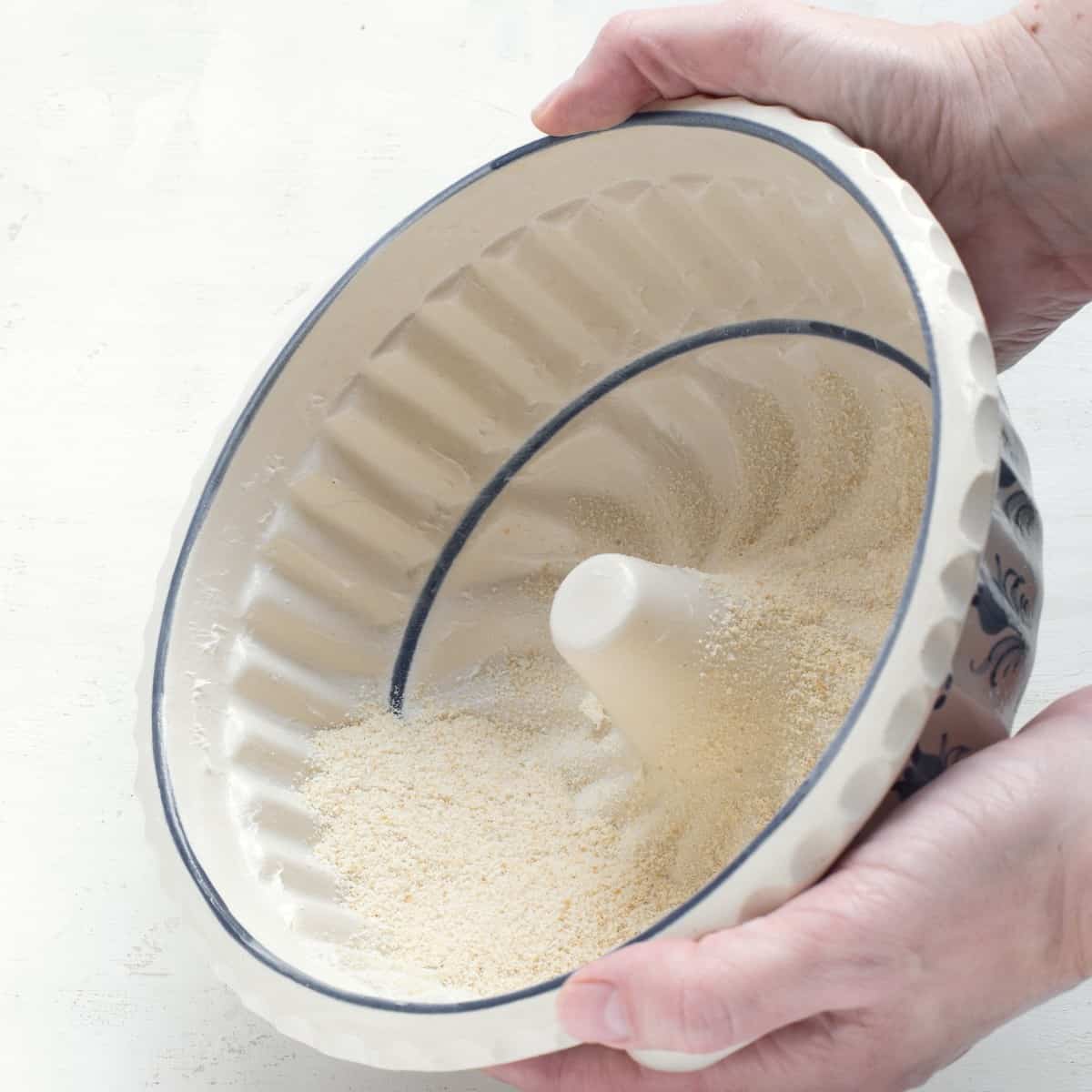Do you want to make a stunning cake with a unique shape that will turn heads? Then a bundt pan is the perfect tool you need!
But before you start mixing batter, there's one crucial step: greasing and flouring the pan. Doing so ensures a seamless release and no sticking.
I'll show you my tried-and-tested method of greasing and flouring the bundt pan so that your baking is always a success.

Bundt cake in the Czech Republic is known as "bábovka" and is one of the most popular desserts that Czechs bake on weekends. Get the recipe for Czech bábovka bundt cake.
➜ What is a bundt pan?
A bundt cake pan is a type of cake pan with a distinctive ring-shaped design. The shape of the pan allows for cakes to be baked with an intricate pattern on the outside, and it also helps to create a more even baking surface.
➜ What you need

- A bundt cake pan; clean it first using warm soapy water and make sure to dry the pan thoroughly with a dish towel or paper towels. Pay special attention to any stuck-on residue that may have remained in the pan from the last baking - you need to remove these.
- Solid fat; such as vegetable shortening or Crisco if you are based in the US. As a Czech, I often use lard for greasing. Avoid using cooking spray or cooking oil when dusting the cake pan with flour or breadcrumbs, as these won't adhere firmly to the sides and may run down. In addition, I avoid using butter to grease bundt pans because the milk solids can cause the cake to stick.
- Flour, or better breadcrumbs; I have found it works best to dust the cake pan with fine breadcrumbs. I make my own breadcrumbs by grinding fully dried, plain French baguettes, Czech veka bread, rohliky rolls, or housky braided rolls. I don't recommend using coarse flour as a semolina, as it creates a hard crust after baking and unnecessarily spoils the impression of an otherwise delicious cake.
➜ Greasing and flouring a bundt cake pan the right way
STEP 1: Grease all the nooks and crannies inside the cake pan with care. Keep working your way around the pan, preferably with your fingers, until the whole surface is covered.

MY TIP: While I used to grease a pan with a silicone pastry brush, I now find that using my fingers to do so is more efficient.
STEP 2: Sprinkle fine breadcrumbs or plain flour into the greased cake pan. Grasp the mold with both hands and, in a circular motion, fill its inner surface with breadcrumbs. If still necessary, gently shake the pan so that you create a thin, even coating of breadcrumbs on all the spots inside. In particular, the central tube must be completely coated.

STEP 3: To remove excess breadcrumbs, lightly tap the edge of the pan on the counter.

STEP 4: And now, you're finished! Your bundt cake pan is ready to be filled with cake batter.
➜ Should I grease a bundt pan with non-stick coating?
Even if a bundt cake pan has a nonstick coating, it is best to grease and flour it to make sure the cake comes out easily. Nonstick cake pans lose adhesion with use and over time, so it is best to prepare the pan before baking as a preventative measure. By greasing and flouring, you can avoid the disappointment of a cake that doesn't turn out and the waste of ingredients.

➜ How to get a cake out of a bundt pan
Greasing and flouring the bundt pan thoroughly is essential for getting the cake out of the pan after baking, but there is still one more trick to make it easier.
- Let the bundt cake cool in the pan for about ten minutes after taking it out of the oven. After that, with cooking gloves on, turn the cake pan over and check if the cake has been properly released.
- If not, bring a kitchen towel. Soak it in cold water and wring it out. Next, spread and press the towel evenly across the pan.
- If the cake isn't releasing and the towel is warm, you can try again after a while.
⇢ Learn how to tell when my bundt cake is done

➜ What to do with a stuck bundt cake
If even this trick fails and you end up with a stuck bundt cake, don't give up. Although the cake may not be visually perfect, its taste is still delicious. Slice it into aesthetically pleasing pieces and arrange them on a plate. They'll be gone in a flash!
Another option is to use the cake crumbs as a base for another recipe. If the cake breaks while turning out of the mold, I just put the pieces in a bowl and top them with vanilla cream. Incredible goodness!

In conclusion, taking the time to grease and flour a bundt pan is a crucial step in the baking process that pays off. Not only will it help your finished cake look better, but it will also make sure that your baked cake comes out of the pan without sticking or crumbling.
Now go grab your ingredients and a nice-shaped bundt pan, and start creating something delicious! A well-greased and floured pan is sure to make all of your baking endeavors much easier.






Leave a star rating and review or ask a question!